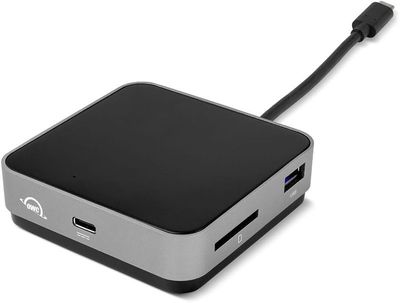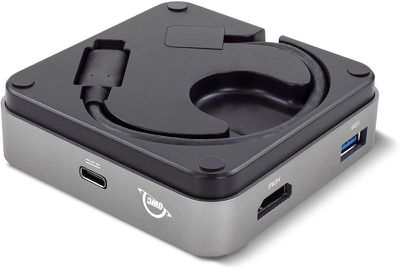OWC today announced the launch of an updated version of its compact, square-shaped Travel Dock, adding new capabilities and design changes.
The new version of the dock features built-in cable storage at the bottom of the accessory, so you can make sure you always have a USB-C to USB-C cable with you when you need it while on the go.

It also supports up to 100W of pass-through power for the first time, up from the 60W supported in the previous version. That means it has enough power for all of Apple's MacBook models, including the 85W 15-inch MacBook Pro.
The OWC USB-C Travel Dock continues to offer a 4K HDMI port, an SD Card reader, two USB 3.1 Type-A ports, and the aforementioned USB-C power pass-through port.

OWC says the dock is compatible with Mac, Windows, Linux, iOS, Android, Windows, and Chrome notebooks and tablets, and for Apple users, it will work with Mac devices and the USB-C iPad Pro.
The OWC USB-C Travel Dock is available from the OWC website for $54.99.
Note: MacRumors is an affiliate partner with OWC. When you click a link and make a purchase, we may receive a small payment, which helps us keep the site running.
























Top Rated Comments
There are solutions and they don’t cost hundreds of dollars. I have zero use for a USB-C to VGA cable, so it’s not costing me any additional money for something I don’t use. I did need some new cables for my devices and it cost me about $50 in new USB-C to Type-**** USB cable to replace the old ones. Done and done.
USB-A is not considered legacy at this point and Apple offers adapters for those who have captive cables that cannot be switched out with a USB-C equivalent. I have a couple for those items that are stuck at USB-A and I have an adapter for them. Otherwise, it’s time for new cables, simple as that. Why this is made out to be some huge imposition on customers is beyond me. Technology changes, by its very nature. Occasionally, changes are more abrupt than others. You adapt and change with it or you don’t and you stay stuck in whatever time period you dig in your heels.
This is not a new phenomenon, when USB was released, companies had to create solutions for serial and parallel connections, first adapters and then cables became the primary way to connect to an older device. They survived for a period of time and eventually, both connectors mostly died out. Sure, there are edge cases, but this is true of technology all the way around. Very little survives the march forward. Listing all the obsolete ports that are no longer in use since the 1970s would take quite a while.
Things don’t move forward if companies don’t force change, it’s that simple. Honestly, should any one of us with zero use for VGA be held back by still having to have that port on a modern computer. The answer is no. It takes up space for something more advanced and more versatile. The same goes for USB-A...it’s still used fairly widely, but even now the tide is turning with more and more devices either have moved to a USB-C port or are offering both cables for users. Eventually, the momentum will shift and USB-A will fade into the sunset. It’s inevitable.
Whether or not VGA is still widely used is irrelevant at this point. It’s horribly obsolete, yet it clings on well past it’s expiration date. It had a very long life and did it’s duty, but let’s not pretend that it’s continued use is a problem for Apple or, for that matter, any other PC OEM.